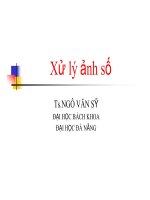Slide Tín hiệu và Hệ thống – Lesson 5 System exercises – Hoàng Gia Hưng – UET
Bạn đang xem bản rút gọn của tài liệu. Xem và tải ngay bản đầy đủ của tài liệu tại đây (263.82 KB, 11 trang )
<span class='text_page_counter'>(1)</span>ELT2035 Signals & Systems. Lesson 5: System exercises. Hoang Gia Hung Faculty of Electronics and Telecommunications University of Engineering and Technology, VNU Hanoi.
<span class='text_page_counter'>(2)</span> Last lesson review ❑ Time domain representation of DT LTI systems ➢ Difference equation: characteristic polynomial, eigenvalues, characteristic modes, zero input response, zero state response, natural response, forced response. ➢ Impulse response: convolution sum and properties ➢ Relationship between impulse response with LTI system properties ➢ Block diagram representation: system reduction ➢ State space representation: state variable, state space, state equations and output equation. ❑ Today lesson: system exercises..
<span class='text_page_counter'>(3)</span> Exercise 1 a. Consider a CT system whose input x(t) and output y(t) are related 𝑡+1 by 𝑦 𝑡 = =𝜏0 𝑥 𝜏 𝑑𝜏 for t>0. Is the system memoryless? stable? causal? b. Consider a DT system whose input and output are related by 𝑦 𝑛 = 3𝑥 𝑛 − 2 − 0.5𝑥 𝑛 + 𝑥 𝑛 + 1 . Is the system memoryless? stable? causal? c. Consider 𝑦 𝑡 = cos 𝜔𝑐 𝑡 𝑥(𝑡). Is the system memoryless? linear? time-invariant? d. Consider 𝑦 𝑛 = 2𝑛 + 1 𝑥 𝑛 . Is the system memoryless? linear? time-invariant? SOLUTION a. Dynamic, stable, noncausal b. Dynamic, stable, noncausal c. Memoryless, linear, time varying d. Memoryless, linear, time varying.
<span class='text_page_counter'>(4)</span> Exercise 2 a. Compute the impulse response of a system described by 𝑦 𝑛 = 2𝑥 𝑛 − 1 − 4𝑥[𝑛 − 3] b. Find the impulse response of a system specified by the equation 𝐷 2 + 4𝐷 + 3 𝑦 𝑡 = 𝐷 + 5 𝑥(𝑡) SOLUTION. 2, 𝑛 = 1 a. ℎ 𝑛 = 2𝛿 𝑛 − 1 − 4𝛿 𝑛 − 3 ⟹ ℎ[𝑛] = ቐ −4, 𝑛 = 3 0, 𝑛 ∉ 1,3 b. Characteristic equation: 𝜆2 + 4𝜆 + 3 = 0 ⟹ 𝜆1 = −1, 𝜆2 = −3 𝑦𝑛 𝑡 = 𝑐1 𝑒 −𝑡 + 𝑐2 𝑒 −3𝑡 1 2. 1 2. Set 𝑦𝑛 0 = 0 and 𝑦ሶ𝑛 0 = 1, we obtain 𝑐1 = , 𝑐2 = − ⟹ 𝑦𝑛 𝑡 = 1 2. 𝑒 −𝑡 − 𝑒 −3𝑡 . Since bn=0, thus. ℎ 𝑡 = 𝑃 𝐷 𝑦𝑛 𝑡 𝑢 𝑡 = Hence ℎ 𝑡 = 2𝑒 −𝑡 − 𝑒 −3𝑡 𝑢(𝑡). 𝐷 + 5 𝑦𝑛 𝑡 𝑢(𝑡)..
<span class='text_page_counter'>(5)</span> Exercise 3 If 𝑓 𝑡 ∗ 𝑔 𝑡 = 𝑐(𝑡), then show that 𝑓 𝑎𝑡 ∗ 𝑔 𝑎𝑡 =. 1 𝑎. 𝑐(𝑎𝑡) with 𝑎 ≠ 0.. SOLUTION By definition: ∞. ∞. 𝑓 𝑎𝑡 ∗ 𝑔 𝑎𝑡 = −∞ 𝑓 𝑎𝜏 𝑔 𝑎 𝑡 − 𝜏 𝑑𝜏 = −∞ 𝑓 𝑎𝜏 𝑔(𝑎𝑡 − 𝑎𝜏)𝑑𝜏. (1). Perform the variable change: 𝑥 = 𝑎𝜏 ⟹ 𝑑𝑥 = 𝑎𝑑𝜏, (1) becomes 1 ∞ න 𝑓(𝑥)𝑔(𝑎𝑡 − 𝑥)𝑑𝑥 , 𝑎>0 𝑎 −∞ 𝑓 𝑎𝑡 ∗ 𝑔(𝑎𝑡) = 1 −∞ න 𝑓 𝑥 𝑔 𝑎𝑡 − 𝑥 𝑑𝑥 , 𝑎<0 𝑎 ∞ Hence 𝑓 𝑎𝑡 ∗ 𝑔(𝑎𝑡) =. 1 𝑎. 𝑐(𝑎𝑡), 𝑎 ≠ 0.. Note: This is the time-scaling property of convolution: if both signals are time-scaled by a, their convolution is also time-scaled by a (and multiplied 1 by 𝑎 )..
<span class='text_page_counter'>(6)</span> Exercise 4 Find [sin 𝑡 𝑢(𝑡)] ∗ 𝑢(𝑡).. SOLUTION By definition: 𝑡. [sin 𝑡 𝑢(𝑡)] ∗ 𝑢(𝑡) = −∞ sin 𝜏 𝑢 𝜏 𝑢 𝑡 − 𝜏 𝑑𝜏 (1). Since 𝑢 𝜏 = 0 ∀𝜏 < 0, (1) becomes 𝑡. [sin 𝑡 𝑢(𝑡)] ∗ 𝑢(𝑡) = 0 sin 𝜏 𝑢 𝜏 𝑢 𝑡 − 𝜏 𝑑𝜏 𝑢(𝑡) (2). Because 𝑢 𝜏 𝑢 𝑡 − 𝜏 = 1 ∀𝜏 ∈ [0, 𝑡], (2) becomes 𝑡. [sin 𝑡 𝑢(𝑡)] ∗ 𝑢(𝑡) = 0 sin 𝜏 𝑑𝜏 𝑢(𝑡) = 1 − cos 𝑡 𝑢(𝑡)..
<span class='text_page_counter'>(7)</span> Exercise 5 Find 𝑓 𝑘 ∗ 𝑔[𝑘], with 𝑓 𝑘 , 𝑔[𝑘] are depicted below.. SOLUTION.
<span class='text_page_counter'>(8)</span> Exercise 6 Find a state-space representation for the system: 𝑑2 𝑦 𝑑𝑡 2. 𝑑. 𝑡 + 9 𝑑𝑡 𝑦 𝑡 + 26𝑦(𝑡) = 24𝑥(𝑡).. SOLUTION 𝑦 (𝑡). 𝑞 (𝑡) Choose the state variables as: 1 = 𝑞2 (𝑡) 𝑑 𝑞 𝑑𝑡 1 ൞𝑑 𝑞 𝑑𝑡 2. 𝑡 =. 𝑞2 𝑡. 𝑡 = −26𝑞1 𝑡 − 9𝑞2 𝑡 + 24𝑥 𝑡. 𝑑 𝑦 𝑑𝑡. (𝑡). , we have:. .. Hence, the state space representation of the system is: 0 1 0 𝒒ሶ 𝑡 = 𝒒 𝑡 + 𝑥 𝑡 −26 −9 24 𝑦 𝑡 = 1 0 𝒒 𝑡 + 0 𝑥(𝑡).
<span class='text_page_counter'>(9)</span> Exercise 7. SOLUTION.
<span class='text_page_counter'>(10)</span> Exercise 8 Consider the system in the given block diagram. If we define new states as 𝑞1′ 𝑡 = 𝑞1 𝑡 − 𝑞2 𝑡 and 𝑞2′ 𝑡 = 2𝑞1 𝑡 , find the new state variable description and draw its corresponding block diagram.. SOLUTION ➢. The description with state variable 𝑞1 𝑡 , 𝑞2 𝑡 is 𝑨 = 𝑐1. ➢ ➢. 𝛼1 0. 𝑐2 , 𝐷 = [0].. Similarity transformation 𝑻 =. 1 2. 0 −1 ⟹ 𝑻−1 = −1 0. The new state variable description is: 𝑨′ = 𝑻𝑨𝑻−1 𝑏1 − 𝑏2 ′ , 𝒄 = 𝒄𝑻−1 = −𝑐2 2𝑏1. 𝑐1 +𝑐2 2. , 𝐷′ = 𝐷 = [0]. 0 𝑏 ,𝒃 = 1 ,𝒄 = 𝛼2 𝑏2. 1Τ2 . 1 Τ2. 𝛼 = 2 0. 𝛼1 −𝛼2 2. 𝛼1. , 𝒃′ = 𝑻𝒃 =.
<span class='text_page_counter'>(11)</span> Exercise 8 (cont.) SOLUTION (cont.) ➢. The corresponding block diagram is. 𝛼2. 0.5(𝛼1 − 𝛼2 ). 𝛼1.
<span class='text_page_counter'>(12)</span>







